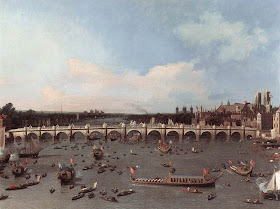Victoria here. It seems like ages since I was in Washington D.C. with my friends Diane Gaston, Julie Halperson and Carol Stroud, but seeing the calendar page turn to May reminded me that I have not yet posted on our visit to the National Gallery to view the exhibition Venice: Canaletto and His Rivals. The exhibition will close on May 30, 2011, so you have a limited time to enjoy the show, as we four did last March. Above is The Piazza San Marco and the Piazzetta, Looking Southeast, c. 1743, from the National Gallery's permanent collection, gift of Mrs. Barbara Hutton.
For more information on the exhibition and the National Gallery's collections, click
here.
 |
| The Catalogue |
The exhibition was organized by Washington's National Gallery and the UK National Gallery in London, where it was seen October 2010-January, 2011.
Here is a link to the UK's description of the exhibition.
Canaletto, The Entrance to the Grand Canal, looking West, with Santa Maria della Salute, about 1729
© The Museum of Fine Arts, Houston. The Robert Lee Blaffer Memorial Collection, gift of Sarah Campbell Blaffer
In the 18th Century, the city of Venice was a magnet for travelers, a city that fascinates even today with its unique setting, magnificent architecture and amazing cultural assets. Many of these travelers were British aristocrats and students on their Grand Tour, an essential part of a gentleman's education. Among the mementos of their travels, many chose to buy views of Venice to be shipped home for the admiration of friends and associates.
 |
| The Stonemason's Yard, National Gallery, London |
Works by Canaletto were especially prized by these travelers, though a number of painters also created majestic cityscapes, both of the principal government buildings and festivals and of the ordinary people going about their daily tasks. The paintings usually had a panoramic sweep of city views combined with very detailed portraits of individuals and animals. One huge canvas had hundreds of gondolas, other boats, people, birds and fowl, and, at a very close look, a dog relieving himself against a building. We examined many of the pictures for all these details and could have spent many more hours before we exhausted the possibilities: a woman peeping out of a window, a sailor tipping his hat, a lady holding tight to her skirts in the breeze.
Canaletto, The Bacino di San Marco, about 1738-9, © Museum of Fine Arts, Boston. Abbott Lawrence Fund, Seth K. Sweetser Fund, and Charles Edward French Fund
The description of the exhibition states, "Venice inspired a school of competitive view painters whose achievements are among the most brilliant in 18th-century art. The exhibition celebrates the rich variety of these Venetian views, known as vedute, through some 20 masterworks by Canaletto and more than 30 by his rivals, including Michele Marieschi, Francesco Guardi, and Bernardo Bellotto. Responding to an art market fueled largely by the Grand Tour, these gifted painters depicted the famous monuments and vistas of Venice in different moods and seasons."
 |
Above, the Moran gondola at the entrance to the exhibition. Photo by Rob Shelley © 2011 National Gallery of Art, Washington
Entrance to the Grand Canal from the Molo, Venice, 1742-44
National Gallery of Art, Washington
Gift of Mrs. Barbara Hutton
Giovanni Antonio Canal (1697–1768) was known as Canaletto, was the most famous of these Venetian vedute painters. The wealthy British merchant in Venice, Joseph Smith, introduced Canaletto and his work to many British aristocrats as early as the 1720's. In 1746, Canaletto brought his skills to Britain, where he painted many famous London landscapes and buildings.
The 1746 view of Westminster Bridge hangs in the Yale Center for British Art
Canaletto returned to Venice in 1755, after painting in London and as far afield as Warwick Castle.
Above is Canaletto's portrayal of London's St Paul's Cathedral, hanging in the Yale Center for British Art.
Above, Warwick Castle, painted for Lord Brooke (later Earl of Warwick) in 1748-49, also at the YCBA.
Canaletto, The Thames, from the Terrace of Somerset House, Looking Toward Westminster, c.1750
also Paul Mellon Collection, Yale Center for British Art
These last four paintings from the British stay of Canaletto are not part of the National Gallery exhibition, but fit well with the theme of this blog nevertheless.
To return to the exhibition Canaletto and His Rivals, we conclude with this view of the Rialto Bridge by Francesco Guardi (1712-1793), perhaps the last of the Venetian vedute painters to achieve lasting renown.
Francesco Guardi, Grand Canal with the Rialto Bridge, Venice, probably c. 1780
National Gallery of Art, Widener Collection
If you can get to Washington D.C. this month, be sure to visit this excellent exhibition.
|












Victoria, it looks like a fabulous collection!
ReplyDeleteI just the the Canaletto's at the YCBA because I finally took my birthday trip to see the Lawrence exhibit. Sigh. It really was wonderful!